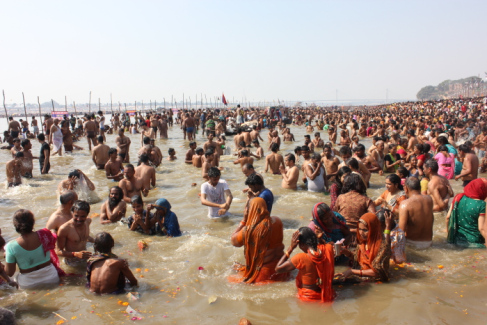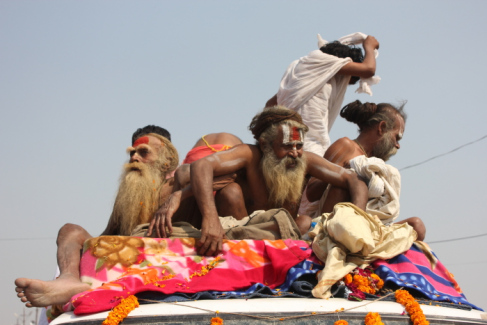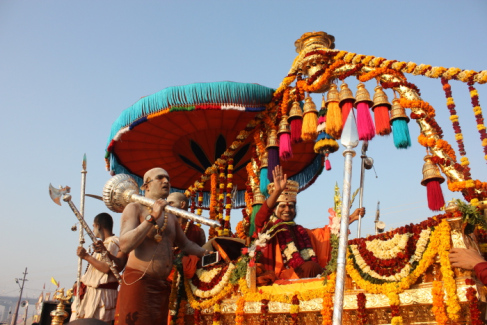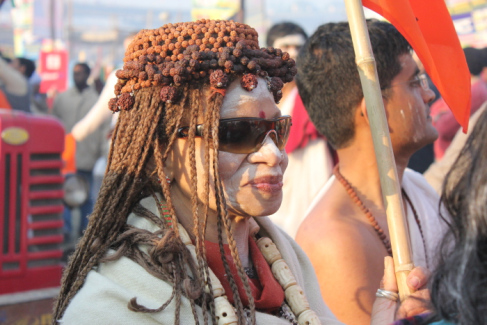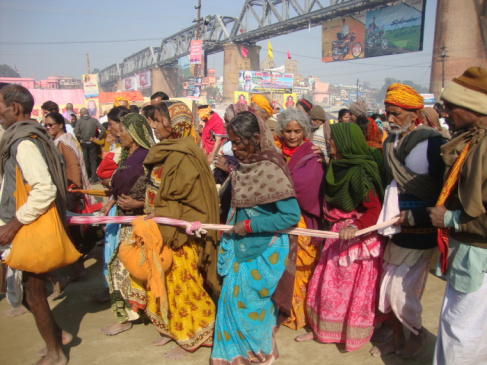We drove 645 km, dealt with hours of traffic jams and walked 7 km in the dead of the night to reach Sangam. Enveloped in a cloud of mist with no beginning or end, the air was dense with chants, wails and cacophonic public announcements. We stood stupefied at how the darkest moonless sky had split and fallen on either side of Shastri Bridge leaving galaxies of stars and the holy Ganga gliding under our feet. The entire 4000 acre campsite on the riverbed was aglow with lights, stretching into infinity as a grid of tents, bridges and lanes.
**
We had made it to Allahabad to be counted amidst the four crore people who descended from every corner of India and elsewhere. This was the Maha Kumbh, the largest gathering of humans on earth. And to our luck, a strange planetary alignment occurring once in 147 years had made the already significant Mauni Amavasya bathing day (Feb 10), tremendously important.
**
Over centuries, this ritual bathing phenomenon has grown to epic proportions. Despite the backdrop of chaos, the inevitable dread of getting lost, mugged, drowned, infected or squelched under a stampede, the Maha Kumbh is an extraordinary event that leaves a lasting impression. It stretches the boundaries of one’s beliefs and imagination in ways like never before. Depending on one’s state of being, the Maha Kumbh mela (fair), can take on any form – at best a sublime spiritual experience or a bizarre nightmare at worst. Without doubt, it is a great barometer to gauge the role of faith and feats of human endurance.
**
No wonder, visitors, scholars, management experts and media from across the world had joined the congregation to experience and be overwhelmed by the sheer scale of operations. Sages and statesmen, celebrities and commoners, sinners and saints, entertainers and entrepreneurs, families and destitutes, young and old, diseased and dying, had come together to wash their accumulated sins in the hope of attaining moksha (liberation).
**
Chinese monk and chronicler Xuanzang, who undertook a 17 year journey through India between 629–645 CE, was probably the first foreigner to provide a written record of the Kumbh Mela. It has been painstakingly documented by several people over the years. More remarkably, it has been photographed from outer space (on Mauni Amavasya, 2001) as evidence of the largest human gathering in the world. Great things have happened at the Kumbh Mela. For those who have read Paramahansa Yogananda’s Autobiography of a Yogi, it was during the Kumbh Mela of January 1894 at Prayag that his Guru Sri Yukteswar met Mahavatar Babaji for the first time.
**
So what makes the Kumbh Mela such a big spectacle? Hindu mythology and the ancient Puranas associate the Kumbh Mela with the Samudra Manthan event. When the cosmic ocean of milk was churned by the gods and demons for the sacred pot (kumbh) of nectar with the key to immortality, the craze for power resulted in a war that lasted 12 days and 12 nights (comparable to 12 human years). Fearing that power would fall into wrong hands, Lord Vishnu beguiles the asuras as Mohini the enchantress while Garuda flies away with the pitcher. En route, a few drops of the eternal elixir spill at Prayag, Haridwar, Ujjain and Nashik.
**
Hence the Kumbh Mela is celebrated on rotational basis every three years in these four holy places. The Ardh (half) Kumbh Mela is celebrated every six years at Haridwar and Prayag, the Purna Kumbh takes place every 12 years at Allahabad but the Maha Kumbh occuring every 144 years dwarfs all other ritual baths or pilgrimages. It is believed that at the propitious moment the waters turn into amrit (nectar of immortality) infusing it with extraordinary cleansing and therapeutic powers.
**
This year the Maha Kumbh began with the first Shahi Snan or Royal Bath on Makara Sankranti (January 14) and Maha Shivratri ( March 10) marks the final day of the 55-day event. Mauni Amavasya, a day of quiet introspection, is considered the most auspicious bathing day and witnesses the highest congregation of people. It is the day when 13 akharas enter the Sangam (confluence of rivers) for the ceremonial bath. Formed around the 8th century, the akhara or ‘wrestling arena’ refers to an organization of various sects of sadhus.
For centuries, the akharas have been centres of martial arts and social welfare, entrusted with the responsibility of protecting dharma whenever it came under threat. The order of entry into the water is fixed according to hierarchy. Traditionally, the bathing ritual is initiated by the Naga babas of Juna Akhara, the oldest protectors of religion, followed by the Niranjani and Mahanirvani akharas and so on.
**
From a distance the gargantuan churn of people at the grounds, along the walkways and pontoon bridges and riverbank, resembled the proverbial cosmic ocean. There were people everywhere. Camps varied from plush to extremely basic according to one’s budget and influence. Food was being distributed freely at several places. Devotees who had endured arduous journeys sat down to listen to spiritual discourses or curled up under blankets. Others were in various states of preparation for a sacred dip. In another hall people lined up to receive prasad. Outside, an endless river of pilgrims flowed by while a train chugged past overhead, brimming with passengers who clung like burr to its sides. Vendors with religious paraphernalia spread out on mats.
**
Several convoys packed with mahamandaleshwars (religious heads), spiritual gurus and their chelas (followers) seated atop decorated chariots and vehicles rolled past us, stirring up the place with drumbeats, hailing ‘Har Har Gange’ and flinging flowers at the populace. Mounted police and guards pushed the crowds aside to give free access to the akharas heading towards the Sangam.
**
Foreigners danced with joy as they escorted the ISKCON chariot drawn by magnificent bulls. From the infamous Nityanand Swami to Paramhans Dati ji (Shani Maharaj), the Dalai Lama to Chidanand Swami spearheading the Clean Ganga campaign, we were surfing through spiritual TV channels in 3-D! Kagal Das Baba with a megaphone in his hands and an endearing smile looked more like a reggae star.
We sought cover near a trash can in the centre of all the action. The cyclonic force of their arrival left us awestruck. The ash-smeared, dread-locked, bare-bodied Naga sadhus who shunned all material things were rushing towards the waters from all around us, shouting and chanting. Some moved with lean athletic grace, some limped their way while their worldlier counterparts in silken robes and glares waddled with a gaggle of followers clearing their path, holding ceremonial umbrellas and fanning them with chamars (fly whisks made of yak tails).
**
Some babas who looked above 147 years old were borne on the backs and shoulders of those who seemed just as ancient! Our eyes zoomed in and out on faces coloured red, yellow and grey with vermillion, turmeric, sandal and ash, dreadlocks beaded with rudraksh seeds, dreadlocks down to the ankles being dried in the sun, braided beards, spiral beards, paunches, ribs, broken hands in casts, hands brandishing tridents and swords, hands touching the feet in reverence, backbones bent, wheelchairs, metal chastity belts, chillums exchanged, toothless smiles, searching grey eyes, wet bodies – we spun like dervishes in a trance, caught in the heart of this religious vortex.
**
Heaps of footwear littered the sandy path towards Triveni Sangam, the confluence of the Ganga, Yamuna and mythical Saraswati. These abandoned and broken slippers stood mute testimony to the crush of people. Small clusters performed the ritual of Gau Daan (donating a cow) to Brahmin priests. The tradition signifies the act of safe passage across the Vaitarni, the subterranean river of death, by holding the tail of a calf. Women fanned out to dry their colourful saris after their bath. Kalpvasis (devotees performing month-long austerities) listened to their gurus with rapt attention. Theatrical performers on stage competed with loudspeakers that boomed public announcements.
**
We heard unending lists of descriptions about people and wailing children who were lost and waiting at the Bhule Bhatke Shivir (Lost and Found stall). For years, getting lost in the pandemonium of the Kumbh Mela had been a recurrent theme in films! We noted people walking with fingers clasped so tight, their knuckles were white. Bigger groups chose to tie themselves together using ropes while some cliques of women knotted their saris and dupattas together to avoid such calamity.
**
Waves of people swelled towards the edge of the 22 ghats stretching across 18,000 feet for their turn to bathe. As we waded into the brown icy water, flower petals, incense sticks, earthen pots and coconuts bobbed around us. We dunked our heads and sipped the sacred waters, throwing warnings about cholera into the ripples. Hordes of people splashed in the water gleefully as some meditated and offered salutations to the sun and river.
**
We waded further and turned to gape at the vision of millions of people hanging by the waterfront. It was a human version of the Great Migration of wildebeest in the Masai Mara. Frail quivering bodies with nostrils flaring in fear and anticipation, pushing and jostling each other, the palpable do-or-die vibe in the air, the heady euphoric religious frenzy, love, devotion, desperation, brotherhood…this was a confluence of everything.
Unprecedented crowds and such a grand coming together of spiritual masters and VVIPs at one venue can take a toll on the city’s infrastructure. Every mela sees a significant boost in security, medical facilities as well as administration of the event on ground, and this year seemed rather organized with traffic control, mounted police etc. However, the sheer number of people swarming into Allahabad led to an unfortunate stampede in a railway station, resulting in the loss of 37 lives and a fire mishap at the campsite.
**
Later, an overnight road block left many stranded in their vehicles. We saw families bracing the bitter cold with no choice but to sleep in the open, on dirty pavements and roads. A few days later, sudden torrential rains threw another spanner in the works by flooding the campsite and several flight cancellations. Such factors do make even the best arrangements seem woefully short.
**
Yet, the devout will continue to throng this great river festival with ardour. For this incredible journey is an act of volition, a penance undertaken without complaint, a promise to fulfil and a mission to seek one’s own personal truth.
Authors: Anurag Mallick & Priya Ganapathy. This article was originally written for a newspaper.






